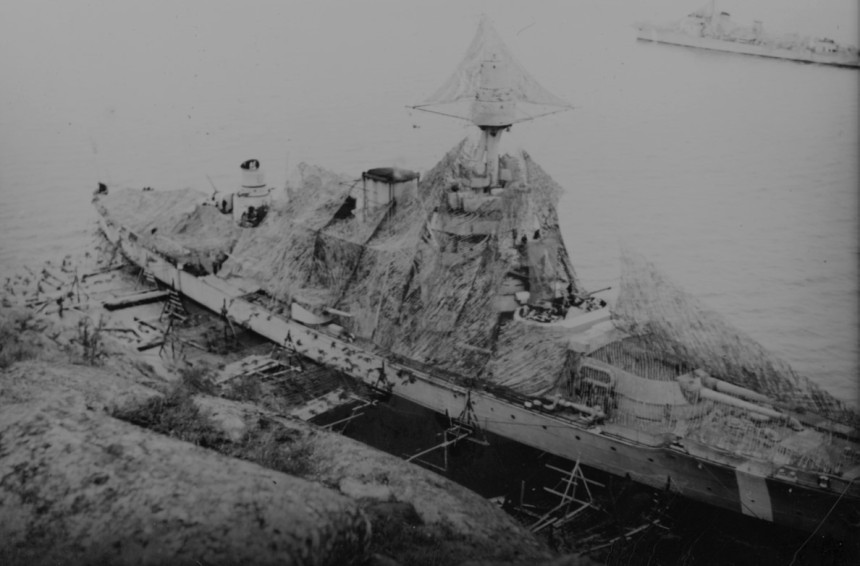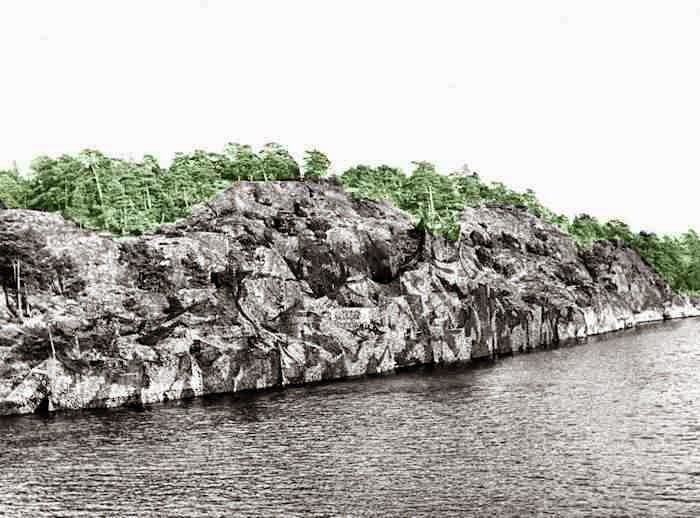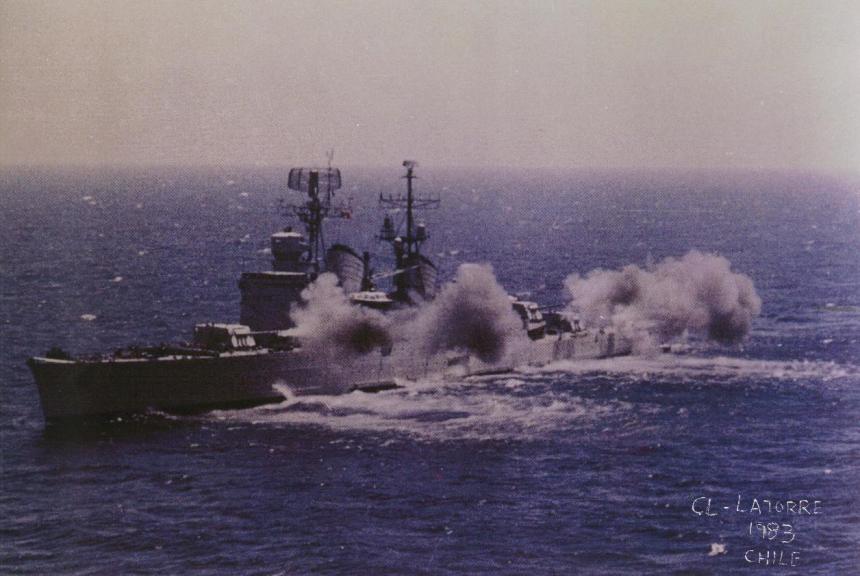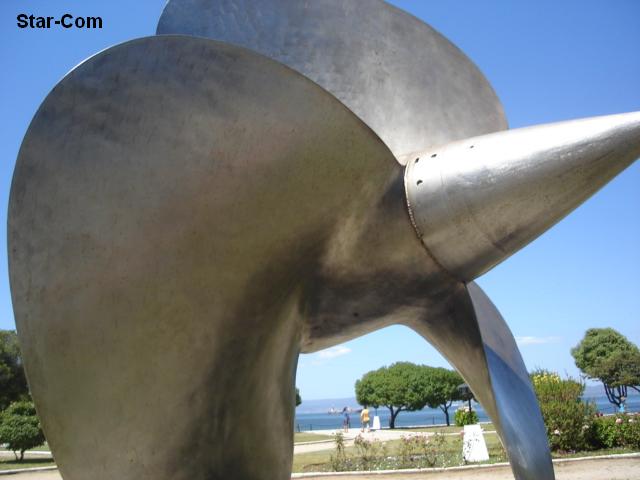Warship wednesday december 3, 2014, the hidden scandinavian lion
Here at LSOZI, we are going to take off every Wednesday for a look at the old steam/diesel navies of the 1859-1946 time period and will profile a different ship each week. These ships have a life, a tale all of their own, which sometimes takes them to the strangest places.- Christopher Eger
Warship Wednesday, December 3, 2014, The Scandinavian Leviathan
Here we don’t see the Tre Kronor-class cruiser Hennes Majestäts Skepp (HSvMS) Göta Lejon (Gothic lion) of the Royal Swedish Navy. Her ship’s motto was Nemo me impune lacessit (“No one provokes me with impunity”) and she meant to back that up as needed.
Can’t see her?
How about now in this enhanced photo?

Ok, this may actually be a destroyer, or a banana, or Tom Sawyer’s raft, but how can you tell for sure?
The Swedish navy has had a long history of camouflaging their ships while hidden next to rocky isolated inlets and islands, even large capital ships– note the bluejackets standing on mine rails

Swedish coastal defense battleship HSwMS Gustav V, using extensive camouflage, a serious tactic used to great extent by the Swedes, especially for air defense
Designed before the start of World War II, the Tre Kronor (Three Crowns)-class of three fast cruisers (Kryssaren) were to each serve as a flotilla flagship of a new squadron of four destroyers and six motor torpedo boats. As such, they were much larger, faster, and modern than the long long line of 18 Pansarskepps (literally “armored ships”) coastal defense ships built for the crown between 1897-1918.
The three most modern (but still slow) pansarskepps would form a strategic reserve while the three new cruisers would race their destroyers up and down the coastline, sinking enemy ships and laying minefields as needed. Capable of sinking smaller fast ships and running away from those that could wreck them in turn; they were supposed to be “stronger than the quicker and quicker than the stronger.”

Note the twin rear mine-laying chutes in stern and pair of twin 152mm turrets facing the national ensign.
Built to an Italian design, when the war broke out in 1939 the third ship was cut, with just class leader Tre Kronor and her sister, Göta Lejon remaining. With construction beginning in 1943 as the country suffered from shortages of everything due to her tense neutrality during WWII, they were only completed by Eriksbergs Mekaniska Verkstads AB, Gothenburg after the war’s end.
Armed with 7 M1942 Bofors 6-inch (152/53 mm) high-elevation guns, each capable of firing an impressive 10-rounds per minute (with a combined broadside of 70 rounds per minute) due to automatic loaders, she was classified as a light cruiser. They could fire a 99-pound AP/HE shell out to 28,400 yards and could be used in an AAA role if needed due to their high elevation.

*As a side note, these guns were designed as 5.9-inchers by Bofors for the Royal Dutch Navy (Koninklijke Marine) cruiser De Zeven Provinciën. After the German invasion of the Netherlands in 1940, these artillery pieces were confiscated by the Swedes and promptly recycled into their new cruisers, stretched to accommodate the Swedish standard 6-inch shell. The DZP did eventually get a new set of guns of the same type delivered by Bofors— after the war. The sole survivor of the class, currently in service as the BAP Almirante Grau (CLM-81) of the Peruvian Navy, is the last WWII-era “gun” cruiser in fleet service.
152mm shells aboard Gota Lejon Photo Wiki
For dooming larger vessels, Göta Lejon carried a half-dozen 533mm surface torpedo tubes. Her armor was adequate, at 2.8-inches, to defend her against destroyer-sized weapons while it was hoped her 33-knot speed could move her away from bigger brawlers. AAA was accomplished with ten twin 40mm Bofors (after all, the company was based in Sweden) and several smaller guns.

Iced in. Note early pre-modernization superstructure tower
Built as a large, well-armed minelayer of sorts, Göta Lejon could carry up to 150 heavy (300# warhead) contact mines in a hold below decks and rapidly drop them over the stern after running them down her topside deck on fitted rails.

Hey, that’s MINE! (Get it)
Gota Lejon dropping it while it’s hot. She could sow mines at 20-knots if needed and her crew got the hustle on. Photo Wiki
Mines are a big business in the Baltic. An estimated 200,000 mines were laid by all sides in the East of Sweden and the Straits of Kattegatt and Skagerrak to the West over the course of the two world wars and are still regularly encountered.
Commissioned 15 December 1947, Göta Lejon had a tense span of Cold War service with an increasingly active Soviet Navy poking its nose into Swedish waters. Over the next ten years, the older pansarskepps were retired while just the two cruisers endured.

Swedish cruisers kryssarna Tre Kronor and Göta Lejon together in 1951 in a rare meeting in Stockholm when both were active at the same time

A good close-up of how she looked as commissioned. She had a usual main battery layout with a triple singe turret forward and two twin turrets aft. Note the HF/DF gear under the bridge.
Then, in 1958, her only slightly older sister and class leader Tre Kronor was laid up, leaving the Göta Lejon as the principal ship in the Swedish Navy, a legit WWII-style cruiser in a 60’s era fleet of mosquito boats and tin cans.
As such she was modernized, given advanced surface and air-search radars (Type 277 and Type 293), and her AAA suite augmented by more modern Bofors 57mm guns. Further, she was fitted to carry helicopters as needed.
Gota Lejon at anchor. Note the swabbie greasing and coating the mine rails as a Mauser-armed platoon of sailors drills nearby. The Swedish navy has long used national servicemen and, as with any large group of semi-motivated young men, must be kept busy. Photo Wiki
Tre Kronor (rear) and Göta Lejon (front) in Karlskrona, 1964, note the laid-up sister has been camouflaged as has the active-duty cruiser. Photo by Ingvar Andersson

As she appeared in 1978. The Swedes were very into camo by this time. Note the large surface search radars
Tre Kronor was scrapped in 1964 as Göta Lejon remained, kept alive in part with items cannibalized from the elder whose steel was repurposed as a pontoon bridge.
A 15-minute long Swedish film from 1964 showing the cruiser under steam, in operations in the Baltic, laying mines (at the 3-4 minute mark) getting all camoed up (at the 9-ish minute mark), delivering broadsides (13 mins), and dropping depth charges.
In 1970, it was planned to modernize the ship by removing her aft turrets and replacing them with U.S. Terrier missiles. However, this plan was scrapped, as it would likely have brought political repercussions from the nearby Soviets.
With time marching on and no refit in sight, by 1 July 1970, after 24 years of service, she was withdrawn from the King’s naval list and transferred to the Republic of Chile the same year.

At a hard turn. Note the extreme 70-degree elevation on the 152mm mount forward.
Renamed Almirante Latorre (CL-04) after the revered Jutland-veteran battleship of the same name, the ship sailed to Latin America and gave a hard dozen years service to that fleet, serving as a counter to the aging Argentine Brooklyn-class light cruiser ARA Gen. Belgrano and Peruvian BAP Almirante Grau (small world) in times of tension.
However, despite a limited refit when transferred, she was in poor condition again in just a few years and by 1980 rarely sailed. On 2 January 1984, she was decommissioned and held in reserve for two years.

Then, in Sept. 1986, she was sold to the Shion Yek Steel Corp of Taiwan, tugged across the Pacific, and scrapped. No doubt her good Swedish steel has been re-blended and recycled into a myriad of household items by now.
Nevertheless, at least one of her screws is retained on display in Chile while her original Göta Lejon bell and shield remain in Sweden.
Specs:

CL Tre Kronor 1964-70. Image by ship bucket
Displacement: 7,400 long tons (7,519 t) standard, 9,200 long tons (9,348 t) full load
Length: 174 m (570 ft. 10 in) (pp)
182 m (597 ft. 1 in) (oa)
Beam: 16.45 m (54 ft. 0 in)
Draft: 5.94 m (19 ft. 6 in)
Propulsion:
Two shaft geared turbines, 4× 4-drum boilers,
100,000 shp (75,000 kW)
Speed: 33 knots (61 km/h; 38 mph)
Complement: 618
Armament: As-built:
7 × Bofors 152 mm guns
20 × 40 mm guns
7 × 25 mm guns
6 × torpedo tubes
Post-1958:
7 × 152 mm (6 in) guns
4 × 57 mm Bofors
11 × 40 mm guns
6 × torpedo tubes
Armor:
Belt: 70 mm (2.8 in)
Deck: 30 mm (1.2 in) upper, 30 mm (1.2 in) main
Turrets: 50–127 mm (2.0–5.0 in)
Conning tower: 20–25 mm (0.79–0.98 in)
If you liked this column, please consider joining the International Naval Research Organization (INRO), Publishers of Warship International
They are possibly one of the best sources of naval study, images, and fellowship you can find http://www.warship.org/
The International Naval Research Organization is a non-profit corporation dedicated to the encouragement of the study of naval vessels and their histories, principally in the era of iron and steel warships (about 1860 to date). Its purpose is to provide information and a means of contact for those interested in warships.
Nearing their 50th Anniversary, Warship International, the written tome of the INRO has published hundreds of articles, most of which are unique in their sweep and subject.
I’m a member, so should you be!















